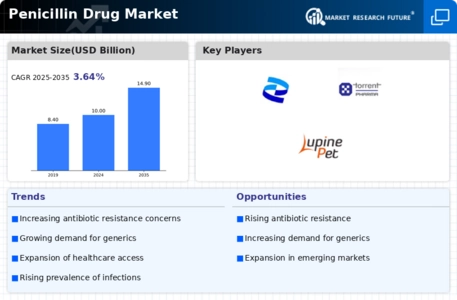Expansion of Healthcare Infrastructure
The expansion of healthcare infrastructure in various regions is contributing to the growth of the Penicillin Drug Market. As more healthcare facilities are established, the accessibility of antibiotics, including penicillin, is improving. This expansion is particularly evident in developing regions, where increased investment in healthcare is leading to enhanced medical services. The World Health Organization has reported a rise in healthcare spending, which is likely to facilitate the procurement of essential medications. Consequently, the Penicillin Drug Market stands to gain from this trend, as healthcare providers are more equipped to treat bacterial infections effectively. The increased availability of penicillin in hospitals and clinics may lead to higher prescription rates, thereby driving market growth.
Rising Awareness of Antibiotic Stewardship
The growing awareness of antibiotic stewardship programs is influencing the Penicillin Drug Market positively. These programs aim to promote the appropriate use of antibiotics to combat resistance and ensure effective treatment. As healthcare professionals become more educated about the importance of responsible antibiotic use, there is a potential shift towards penicillin, which is often preferred for its efficacy and lower resistance rates compared to other antibiotics. This trend may lead to an increase in penicillin prescriptions, as healthcare providers prioritize effective treatment options. Furthermore, the Penicillin Drug Market could see a rise in demand as educational initiatives encourage the use of penicillin for specific bacterial infections, thereby enhancing its market position.
Increasing Incidence of Bacterial Infections
The rising incidence of bacterial infections is a primary driver for the Penicillin Drug Market. As antibiotic resistance becomes a growing concern, the demand for effective antibiotics, including penicillin, is likely to surge. According to recent data, bacterial infections account for a substantial percentage of hospital admissions, necessitating the use of antibiotics for treatment. This trend indicates a potential increase in the market size, as healthcare providers seek reliable solutions to combat these infections. The Penicillin Drug Market is poised to benefit from this increasing need, as penicillin remains a cornerstone in the treatment of various bacterial infections, including pneumonia and strep throat. Furthermore, the ongoing research into the efficacy of penicillin against resistant strains may further bolster its market presence.
Regulatory Support for Antibiotic Development
Regulatory support for antibiotic development is emerging as a significant driver for the Penicillin Drug Market. Governments and regulatory bodies are increasingly recognizing the need for new antibiotics to combat rising resistance. Initiatives aimed at expediting the approval process for antibiotics, including penicillin, are likely to encourage pharmaceutical companies to invest in research and development. This support may lead to the introduction of new formulations and delivery methods for penicillin, enhancing its therapeutic applications. As a result, the Penicillin Drug Market could witness an influx of innovative products, catering to diverse patient needs. The proactive stance of regulatory agencies may also foster collaboration between public and private sectors, further stimulating market growth.
Technological Advancements in Drug Production
Technological advancements in drug production are playing a crucial role in shaping the Penicillin Drug Market. Innovations in manufacturing processes, such as fermentation technology and bioprocessing, are enhancing the efficiency and yield of penicillin production. These advancements not only reduce production costs but also improve the quality of the final product. As a result, pharmaceutical companies are likely to increase their output of penicillin, meeting the rising demand for antibiotics. The Penicillin Drug Market may experience growth as manufacturers adopt these technologies to streamline production and ensure a consistent supply of penicillin. Additionally, the ability to produce penicillin more efficiently could lead to competitive pricing, further driving market expansion.


















Leave a Comment